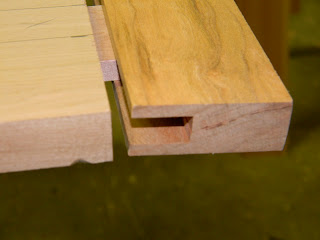As I get older, I know I'm not getting smarter, but I'd like to think I'm getting wiser (not sure my wife would agree). And with that in mind, here's a shot of a table top that I'm doing. I found some wide red birch boards for the top, and in the past I would have tried to glue the whole thing up in one shot, nowadays I glue two boards together, then add a third, and finish off with the forth. I really is a much less frantic approach. And I think it save time in the end because I'm able to get the boards to line up better, which results in less planing and sanding.
This helps a lot too. It's a Festool Domino. Essentially it cuts a slot into a board, be it the end or side, and then you insert either a purchased floating tenon, or you can make your own. On this table, I used the purchased Dominos to help with the edge to edge alignment. By cutting slots and inserting the dominos, the two pieces will be perfectly level when you clamp it up. A biscuit joiner will also work. It works about the same, but the biscuit (a football shaped piece of compressed plywood) is quite a bit smaller. Which is fine for edge to edge, because you really don't need the strength because the glue joint is stronger than the wood. I use them just for alignment, and it does help.
Here's another use for the Domino. It cuts slots (mortises) into the end of the tabletop. I'm gonna put on a breadboard end, the piece laying on the top. This goes directly on the end and does two things. One, it covers the end grain of the table, and two, it keeps the table flat. The piece is glued in the middle, and pinned towards the end. The holes have to be slot shaped towards the edges to allow the top to move with changes in humidity. Anyway, the purchased dominos (tenons) I think are a little small for this application, so I made bigger ones out of some scrap birch, and glued them into the slots. Then, today hopefully, I will cut the matching slots in the breadboard, and glue the center and pin the edges. If I were to glue it all the way across, the top would split. The breadboard had to be able to float.
This shows how I used to do cut breadboard ends. I would mill a slot all the way down the middle of the board, and slide it over a mating notch (rabbet) on the table top ends. Then glue the middle and pin the ends. There are a lot of people who do it this way and there are a lot of woodworking books that tell you t do it this way. But when you look at this piece wood, there simply isn't much strength in this piece of wood. Case in point-- I made a coffee table for our house, and my son sat down on the end on the top, and snap, broke the breadboard right off. I had another break because the owner moved the table by lifting on the breadboard. Granted, probably shouldn't have done that, but still. So now, I cut slots and leave some meat between the slots, which should prevent this from happening again. Always evolve.
Here are a couple shots of a piece that joins the side of a big hutch I'm also building. I opted for dovetails on the ends of the rails for a couple reasons. First, it hold the side together and prevents them from bowing apart. Second, I didn't want to see any fasteners on the outside, because then I would have to run a molding around to hide the fasteners, which I didn't want. So by using the dovetails, I just glue it up and tap it into place, no fasteners and it provides a mechanical means to hold the case side together. I just cut the slots with a router and trim the dovetails with a bandsaw. I'm sure there are people who wonder why bother with dovetails when you won't see it on the finished piece. I do it because it's the best joint to use, regardless of whether or not you see it.
Couple more shots. The back piece is made the same way, and together they hold the case sides together. I'll post more pics of this hutch as I go along. It should be really nice. I'm also working on a new chair design, and a cherry bench with slip (upholstered) seat. I've never done one before. The bench and chair I hope to have done in time for a furniture show in June in Lincolnville Point, Camden area, Mid-coast Maine, http://www.mainehomedesign.com/midcoast-show-2011.html. If you plan on being in the area, be sure to check out the show, and stop in and see my booth. It's one thing to see my furniture on the website and blog, but you really should see it live to appreciate it.







Here are the FURNITURE known for their simplistics lifestyles... ‘ Shaker furniture .
ReplyDeleteNorman,
ReplyDeleteIs there a piece in particular you like? or just Shaker in general? Terry